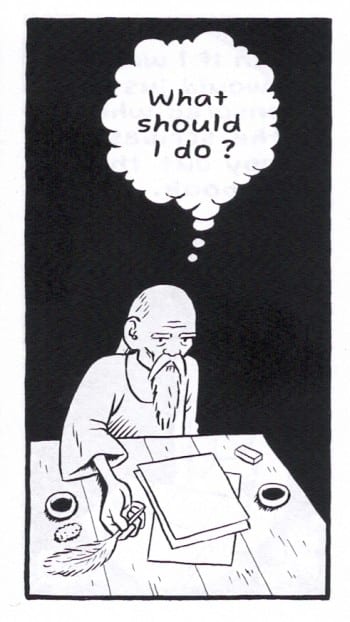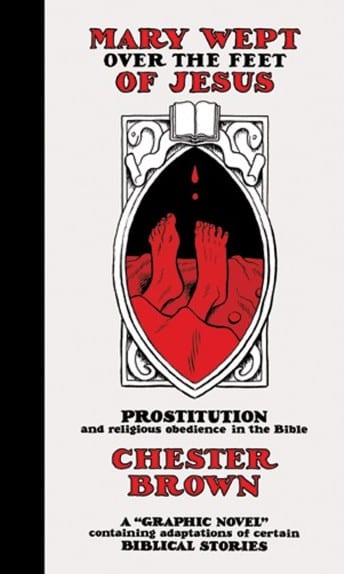
This week marks the release of a new work by Chester Brown, and with it a volume of supplementary text unseen in Canadian comics since Cerebus closed up shop at century's dawn. Over approximately 97 pages at the rear of the book, we are treated to an Afterword, Acknowledgements, notes on the comics, a 20-page addendum comic, notes on the Afterword, notes on the addendum comic, and then notes on prior notes, along with a 55-item Bibliography... or so it is in the uncorrected proof Drawn and Quarterly sent me. Maybe he's added more. As a reader, I tend to put each portion of the animal to use, and in this sense, coupled with the 'seriousness' of the religious topic, I think the book will be received as sort of a hybrid work, as was Brown's preceding Paying for It. It probably should be. Nonetheless, in the spirit of Christian charity, I will suggest that you -- the I-will-now-presume-sympathetic reader -- temporarily excerpt your initial experience with the book to the preceding 170 (or so) pages of comics, because they function in much their own self-sufficient manner, and actually register as far more pleasing without the interjection of the artist's prose reflections.
Ostensibly a collection of ten new comics adaptations of Biblical stories on the theme of "[p]rostitution and religious obedience," Mary Wept Over the Feet of Jesus, in comics form, is actually a system of ascertaining, intuiting, feeling Brown's particular take on the Judeo-Christian God as favoring disobedience to His word, and rewarding individuals who pursue pleasure and happiness. We know, immediately, that this is an unusual perspective, as Brown's opening depiction of Cain and Abel emphasizes Abel's disregard of vegetarian tribalism to kill animals and consume their meat, an action against Edenic proscription that pleases God but confuses Cain. As it happens, Brown is extrapolating from commentary by theorist Yoram Hazony's 2012 book The Philosophy of Hebrew Scripture, but the lucidity of Mary Wept needs only our recognition that this is an unusual excerpt of Genesis. 'Wrong,' we might say.
This and a similarly unfamiliar version of the parable of the Prodigal Son bookend the bisected meat of the book: four tales of sexual exchange from the Old Testament, and four chronological vignettes relating to the life of Jesus. The Old Testament chapters each adopt the name of a certain woman: Tamar; Rahab; Ruth; and Bathsheba, whom the classics fans among you might recognize as the only four female names specified in the genealogy of the Messiah at the top of the Gospel of Matthew, save for Mary herself, the mother of Jesus, which the late academic Jane Schaberg noted in her 1987 study The Illegitimacy of Jesus as indication of Mary's sexual exploitation by way of literary association. Brown's version of these stories, however, seeks to prioritize the pursuit of survival (indeed, satisfaction) of these women in the face of repressive laws divined by man; in this way, Bathsheba is not merely presented as seducing David, but applauded for such, in comparison to her husband, Uriah, whose subsequent refusal to leave his post to visit his wife -- and thereby obscure the origin of Bathsheba's pregnancy -- is played by Brown as a comedy of needless and self-defeating martial repression. But David still sins before God in sending the man to his death in combat, for what else is less appreciative of life?
These qualities can be ascertained simply from reading Brown's comics, and it is by the arrangement of these comics that he builds his vision of the evolution of divine approval. In the second, New Testament half, we are told immediately and bluntly -- again in the declarative mode of Louis Riel, everything Brown does in this book is exceedingly straightforward, from characters flatly describing their motivations to God's depiction as a large nude man -- that Mary herself is a prostitute, which segues into a wildly different version of the parable of the talents; if you read Brown's copious prose reflections on such, you discover that his version is based on a summary of an Aramaic variant of the story supplied in John Dominic Crossan's 2012 book The Power of Parable, but the appeal of Brown's story is not in this tenuous academic chassis but in the way Brown's arrangement of vignettes creates a palpable through-line of logic for the world he is depicting. How his drawings, simple and clean, adequately substitute this reality for our textual understanding of such from the no-more-accurate 'reality' of scripture, freighted as it is with ritual and circumstance. When Brown later tries to explain his own creative decisions, he often repeats what his comics have already revealed, and sometimes drags the whole thing onto a cerebral, rhetorical plane, rather conspiratorial in its fascination with undoing the presumed censorship of powerful interests.
Clearly, from the amount of text in the back of this thing, Brown sees this aspect of the book as important - or, maybe he just can't bear leaving his intentions unexplained. I wish he would just rest on art; Brown is vastly more effective at allowing the reader to grasp for themselves these scenes of Biblical women presaging and informing the well-recognized sympathies of Jesus for the socially marginalized than, ironically, explaining his counter-explanations to Biblical explanations. when Jesus and Mary of Bethany are drawn in silhouette, appreciating the anointing of his feet, as various disciples are drawn in full, standing outside of the shadows and articulating present-tense impressions, Brown skillfully displays the central conflict of the work. They are unaware of the import of this moment, but you, Brown trusts, now are, enough so to sympathize with Matthew the Evangelist as he broods over the baggage placed upon Christianity in later decades, and enough to accept, as a logical endpoint, Brown's closing vision of the Prodigal Son as not so much a celebration of reconciliation as a repudiation of "resentful subservience."
"I've changed a few details in my retelling of the parable to reflect how I think Jesus told it," Brown remarks in the back. In other words, this time he just made stuff up, but the advantage of reading this comic as a comic, is that this flourish of imagination there seems like an artistic grace note, rather than the presence of conjecture in a debate. But then, books do tend to become debates anyway, and perhaps Brown just wants to set the terms on his own, in a way Matthew, Luke, et al. never could. You don't *have* to agree to those terms, though - certainly not in a comic about disobedience itself!
***
PLEASE NOTE: What follows is not a series of capsule reviews but an annotated selection of items listed by Diamond Comic Distributors for release to comic book retailers in North America on the particular Wednesday identified in the column title above. Be aware that some of these comics may be published by Fantagraphics Books, the entity which also administers the posting of this column, and that I also run a podcast with an employee of Nobrow Press. Not every listed item will necessarily arrive at every comic book retailer, in that some items may be delayed and ordered quantities will vary. I have in all likelihood not read any of the comics listed below, in that they are not yet released as of the writing of this column, nor will I necessarily read or purchase every item identified; THIS WEEK IN COMICS! reflects only what I find to be potentially interesting. You could always just buy nothing.
***
SPOTLIGHT PICKS!

Mary Wept Over the Feet of Jesus: In conclusion, this is a 280-page b&w hardcover release from D&Q. I didn't mention much about the "addendum comic" - it's a massively compressed rendition of the Book of Job that sees Brown adopting an unusual (for him) amount of stylization, with images and sequences recalling Mike Mignola's Hellboy and Osamu Tezuka's Phoenix - maybe you could pluck that little bit out on its own as well; $21.95.

Irmina: Being an English edition of a 2014 album from German cartoonist Barbara Yelin, "a troubling drama about the tension between integrity and social advancement" set in the run-up to World War II, as a young woman seeks to maintain relations with a black student she met while living in London, no longer a friendly territory. Subdued colors and wavy lines on these 288 pages, published by SelfMadeHero in hardcover at 8" x 10.5" and distributed in North America by Abrams. Samples; $24.95.
--
PLUS!
I Am a Hero Vol. 1: Definitely your manga pick of the week, this 464-page brick collects the first two Japanese volumes of a very popular zombie survival series by Kengo Hanazawa, yet another favorite of scanlation readers only now making his formal English-language publishing debut. Join a hapless manga artist (based on the author himself) as he discovers purpose in life through the good fortune of owning a firearm when the flesh-eaters arrive. Extremely oppressive, heavy realism in the drawing, with a flair for manipulating those visual properties to grotesque and sometimes comedic effect. Up to vol. 20 in Japan, so settle in if you like it. Preview; $19.99.
Sooner or Later: For a long while this 1986 serial was one of the more obscure works from writer Peter Milligan and artist Brendan McCarthy - it's a time-travel comedy put together for 2000 AD in the wake of the pair's influential Strange Days series at the American publisher Eclipse with fellow artist Brett Ewins, who had begun drawing the (more popular) Milligan-scripted SF war project Bad Company around the same time. The original being less than 40 pages, this Simon & Schuster release (matching a UK edition by Rebellion) also throws in a brief 1989 sequel drawn by Tank Girl co-creator Jamie Hewlett, as well as a suite of Milligan/McCarthy one-offs and various interviews, for a total of 96 pages; $17.99.
The Nameless City Vol. 1 (of 3) (&) Three Thieves Vol. 6 (of 7): The Dark Island: YA fantasy series here at opposite ends of their lifespans. The Nameless City is the 240-page start of a new trilogy from artist Faith Erin Hicks (colored by Jordie Bellaire) and publisher First Second, concerning an oft-invaded, Chinese-tinged urban terrain that unites unlikely allies in its defense from perpetual turnover. Three Thieves is from Northwest Passage creator Scott Chantler, who began the series with Canada's Kids Can Press in 2010 and has produced a new volume more-or-less annually since. This one is 116 four-color pages, following the exploits of twin adventurers. It's all set to conclude next year; $21.99/$14.99 (Nameless City, HC/SC), $16.95/$7.95 (Dark Island, HC/SC)
Goldie Vance #1 (of 4): But if you like your kids' comics as comic books, BOOM! has one here from popular youth graphic novel specialist and filmmaker Hope Larson, a teen detective series co-created with artist Brittney Williams of Marvel's Hellcat. Larson, for that matter, will soon be writing DC's Batgirl, in continuance of that property's refurbished image. Preview; $3.99.
Cape Horn & An Olympic Dream: The Story of Samia Yusuf Omar: Two more European choices for you, and only you. Cape Horn is a 232-page Humanoids softcover following up on a deluxe hardback from 2014; the work of writer Christian Perrissin and artist Enea Riboldi, this 2005-13 adventure series follows various characters on journeys below South America in the late 19th century. An Olympic Dream advances us to the 21st century, as Reinhard Kleist presents the story of the titular Somalia-born sprinter, who drowned en route from Libya to Italy via a refugee boat. Kleist previously worked with publisher SelfMadeHero on the 2014 English release of his album The Boxer, and Abrams (which itself published Kleist's Johnny Cash: I See a Darkness in 2009) again distributes to North America; $19.95 (Cape Horn), $22.95 (Olympic Dream).
Lone Wolf and Cub Omnibus Vol. 12 (of 12): I don't usually mention continuing series in this column -- the doctors have instructed me to refer to this as "self-care" -- but special exception can certainly be made for this most-revered 1970-76 samurai swordplay series from writer Kazuo Koike and artist Gōseki Kojima, reaching a manly tear-stained conclusion fit to devastate those following along in these 700+ page Dark Horse fatties. Battle on, Ogami Ittō! Samples; $19.99.
Neal Adams' Blood: The spirit of Continuity Comics lives on in this 96-page Dark Horse collection of a violent color action serial Adams wrote and drew for Dark Horse Presents, the solicitation for which promises "an incredible animated 3-D lenticular cover." Not quite indestructible Tyvek, but it will nonetheless draw the eye. I enjoy these very loud and perplexing latter-day Adams projects. Preview; $14.99.
Peter Arno: The Mad, Mad World of The New Yorker's Greatest Cartoonist: Finally - I'm betting you've read Ben Schwartz's very entertaining Vanity Fair profile of the trendsetting satirist of sundry swells, so you might recall some mention therein of an upcoming Arno biography by another gag man, Michael Maslin. Now the tome has arrived, a 304-page Simon & Schuster hardcover release, and absolutely your book-on-comics of the week; $26.95.






